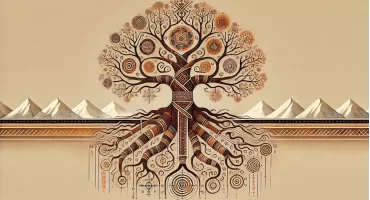High in the mist-veiled cliffs of central Nepal, where the sky breaks open above rhododendron forests and ancient stone villages cling to the earth, the Gurung people have, for generations, practiced a tradition as audacious as it is sacred: the harvesting of mad honey. In recent years, this rite has found its way into the global spotlight—through viral videos and the curious chatter of podcasts, but the gaze of the outside world often settles on the spectacle: men dangling on handmade ladders hundreds of feet above the forest floor, braving swarms of Himalayan giant bees for the intoxicating nectar that lies hidden in the hive.
This holy ceremony is traditionally conducted by an elder who calls forth the cliffs’ guardian spirits and maintains peace between the bees and hunters. This spiritual groundwork reflects the Gurung community’s deep-seated belief in the interdependence of all living beings. The elder’s remarkable immunity to bee stings is often cited as proof of this sacred bond—not a miracle, but a testament to a life lived in balance and reverence for the natural world.
In a prosperous year, nature bestows its gifts in abundance. Honey drapes the boulders in golden cascades, and armed with little more than ropes and woven baskets, the Gurung people set out in small bands, sometimes with extended families who, at times, unite in larger gatherings to celebrate the season’s wealth. Yet these journeys are never random. Each path follows the contours of ancestral land, well-trodden and steeped in memory. Every stretch of terrain and its bounty are entrusted to guardian spirits. Whether the harvest is wild fruit, the yield of cultivated fields, or the revered honey, the most coveted nectar of all, it is gathered under an unspoken covenant between the land and its keepers.

Parallel practices emerge in Sikkim and Darjeeling, where accounts tell of humans forging pacts with animals and insects. For instance, elders recount rituals where jungle-goers who prayed to forest spirits or communicated with ants and spiders were spared from leech and insect attacks. These accounts may seem otherworldly in the modern era, yet they highlight an eco-spiritual ethos where humans coexist with other sentient beings in a web of mutual respect and responsibility.
Of course, no instrument of science can measure this covenant, no microscope can reveal the threads that bind bee and man, cliff and spirit. And yet, one glimpses a worldview carved from centuries of coexistence. It is simply a belief in reciprocity. The natural world, in this Himalayan imagination, is not a warehouse of resources but a parliament of beings, each with its own agency, its own right to exist. What science may call superstition, the Himalayan worldview might understand as memory—a pact, renewed in each season, that all who dwell upon this fragile Earth are bound by the same breath.
Central to this worldview is the concept of eco-spirituality, a belief system that intertwines environmental consciousness with spiritual practice, advocating for a deep, respectful relationship with the natural world. In the Himalayas, this reverence for nature has been at the heart of shamanic traditions for centuries, where sacred rituals, ancestral wisdom, and an intimate connection to the land form the foundation of spiritual life.
What all of this means is that at the core of both eco-spirituality and Himalayan shamanism lies the belief that nature is sacred. The land is not merely soil and stone but a sentient force, pulsating with spiritual vitality, where every being is kin, bound by the same ancestral essence. We are, in the truest sense, woven from the same primordial thread. Shamans, infused with divine energy, serve as the bridge between humanity and the unseen world, channeling rituals that pay homage to the forces sculpting existence itself.
By this very nature, all humans, regardless of culture, share an intrinsic mental perception or a universal shamanic consciousness. Whether this latent faculty is woven seamlessly into daily life, as it was for the ancients, or accessed through the labyrinth of memory embedded in tradition, depends solely on one’s awareness, orientation, and the depth of their interconnected understanding.
In the West, voices like Henry David Thoreau stood as early sentinels of a philosophy that saw nature not as backdrop but as teacher, sanctuary, and moral compass. His retreat to Walden Pond was not an escape but a deliberate act of communion—a spiritual experiment rooted in simplicity and solitude. In many ways, Thoreau’s vision echoes the animistic ethos of Himalayan communities. Thoreau was not alone. John Muir, wandering the Sierras with his pockets full of biscuits, wrote of the wilderness as a cathedral—an unbuilt temple where God might be encountered not in script but in the curve of a river or the ancient patience of a glacier.

In the Himalayas, many shamanic rituals are aligned with the rhythms of the Earth. Shamans often conduct ceremonies that correspond to the seasons—marking the winter solstice, the spring equinox, and the harvest period—celebrating the cycles of nature and ensuring that the human community stays in harmony with the environment. These rituals are seen as a way of thanking the Earth for its abundance and asking for blessings for the upcoming season. Eco-spirituality, too, places great importance on the cycles of nature and the spiritual significance of the seasons. Many eco-spiritual practices involve seasonal rituals that honor the Earth’s gifts, such as planting trees during the spring equinox or celebrating the harvest in the fall. These practices serve as a reminder that we are part of a larger cycle of life, death, and renewal, and that our actions must respect and nurture the Earth’s natural cycles.
Eco-spirituality draws heavily from this traditional knowledge, emphasizing the need to learn from indigenous practices and honor the wisdom of our ancestors. By reconnecting with the land and learning from the deep ecological understanding embedded in shamanic traditions, eco-spirituality encourages a return to more sustainable ways of living—rooted in respect for the Earth.
In the modern era, the teachings of both Himalayan shamanism and eco-spirituality have never been more relevant. As we face unprecedented environmental challenges, the spiritual lessons of interconnectedness, balance, and healing offer much-needed guidance. Young people today, in particular, are turning to eco-spirituality as a way to reconnect with nature in an increasingly disconnected world. Practices such as forest bathing, nature meditation, and eco-activism offer pathways to spiritual fulfillment while also contributing to the well-being of the planet.





Leave a Reply